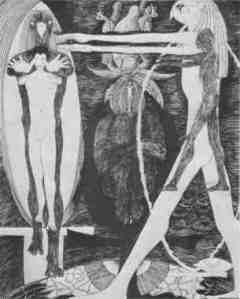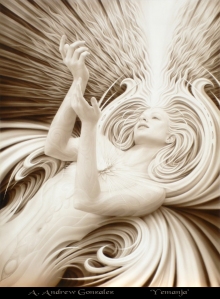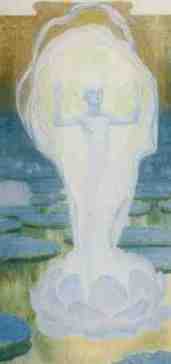The Key to Egyptian Magic, Part 3
We’ve been talking about what I call (for lack of a known ancient Egyptian term for it) Kheperu, “Forms” or “Transformations.” It is a way of taking the imaginal Form or Image of a Deity upon ourselves and—for a specific, limited period—thus Transforming ourselves into the Deity; in this case, Isis.
It’s not exactly the same thing as trance possession or “being ridden” by a Loa, as in Voudon. In the case of Kheperu, the ritualist does not lose their own consciousness. Rather, consciousness is expanded. Assuming a Kheper (sing.) is more like stepping into a stream of Divine power, more like being carried than carrying.
When successfully done, Kheperu puts us in touch with a deeper wisdom that serves as guide in any act of magic, mundane or spiritual. It means no more—and no less—than placing the Divine part of ourselves in contact with a greater Divine power. In this way, we “become” the Goddess. The potential that this offers for spiritual development as well as for practical magic is immense.

People differ in what they believe a Kheper or—as it is often known in modern ceremonial magic—a God/dessform is. Some consider it to be a purely human psychological construct. Some consider the imaginal Form to reflect an archetype, which in turn, reflects a Divine Reality. Most will consider a Kheper to be a little of both—a sacred and enlivened image to which both humanity and Divinity contribute.
I’ve seen some folks using the term “Godform” in a way that suggests that the Form is somehow the whole Divine Being; that “Godform” is just another, perhaps more technical, word for God. Nope. The Form is just that: a form. It is an interface that human beings can use to connect with some part of the Truth of a Deity. I’ve also seen some criticism of using the term “energy” to talk about what we sense in the presence of a Deity as being a bit too new age-y. However, I find it a useful metaphor, so I’m going to continue using it. Feel free to substitute your preferred term if it’s not to your liking.

To me, a Kheper is an image that interprets the Divine energy of a particular Deity or aspect of the Deity to us as human beings. Normally, it would be an image that has some history behind it, an image that has been invested with human spiritual, mental, and emotional energy for hundreds or even thousands of years. When it comes to Isis, we may picture Her in any number of ways that artists have portrayed Her during the thousands of year of Her worship.
To use Jungian terms, we can think of a Kheper as an image recorded in the Collective Unconscious. By assuming the Form, we make it conscious rather than unconscious. These images live by virtue of the energy, both Divine and human, invested in them.
Like the ancient Egyptian who dons the cloak of the Great Lady and becomes the Great Lady, we, as modern devotees, can also put on the cloak or Form of the Goddess and “become” Isis. An invocation of Isis by the technique of Kheperu is a great, sacred cycle of inflowing and outflowing energy, from human to Divine, Divine to human.
If we succeed in doing this, we will certainly know it—for the feeling is very unlike any normal state of consciousness. We may feel as if our body, soul, mind, and spirit have tapped into a stream of power coming from outside ourselves, a stream which extends beyond the physical and touches invisible realms. We may perceive ourselves as enormous, towering over the earth or suspended in space. We may have a feeling of expansion in the heart or little rushes or spasms of energy throughout the body. We will feel the intense presence of Isis and may participate in the creativity and magic that are an essential part of Her nature. Through the Kheper of Isis, we will be able to use some of the power of the Goddess Herself to initiate, empower a rite, charge a talisman, or commune with Her.

Big Magic Caveats
With Big Magic like this, there are always caveats. If you are reading this blog, I will assume that you have some form of devotional relationship with Isis. That’s good. If not, you might wish to develop one before doing this rite. (That’s not to say you can’t take on the Kheper of a Deity you don’t have such a relationship with, just that it will be easier and more productive if you do.)
I probably don’t have to tell you this, but we do not Become the whole Goddess with this technique; rather, we help our own divinity blossom into a little bit of Her. The great Neoplatonist teacher Iamblichus discussed this in relation to theurgy. I’m paraphrasing now, but he tells us that with this technique, we maintain a dual perspective: we are both in touch with Deity and aware of our own natural human place in the world. We know both at once—just as in the Coffin Texts example from last week.
And remember, when we’re doing ANY magical Work, we are always using the only tool we have: ourselves. We are human beings and we come with a full complement of psychological shit packed into our heads and hearts and souls. The more we are aware of our own psychology and as we work to heal what we need to heal, the more we can separate what is our own stuff from Hers. Indeed, Divine contact like this can be part of the therapeutic process. Since Isis is alway ma’et, Right and True, when we align ourselves with Her in this way, we become more ma’et, too.

What’s more, in this process, we will discover that true Divine contact, though very powerful, is humbling and does not idly flatter the ego. We may come to believe, as did the theurgists and Hermeticists of old, that the Divine Ones participate in our assumption of Their Forms not merely because of the ritual or Their harmony with the images, symbols, and names employed, but because of Their Goodness and Divine Love for us. We will see that when we expend our effort to reach out the Them, They will in turn stretch out Their hands to us, guiding us, assisting us in our magic, and most importantly, helping us grow spiritually.

The following rite, Becoming Isis, is from Isis Magic and envisions Isis in Her role of Lady of Heaven, Earth, and the Underworld. If Kheperu is a new technique for you, Isis is an excellent choice as She will be indulgent and kindly as you learn. When you work this rite, you may or may not have success the first time. Either way, it’s okay. Just keep coming back to it. Use your sacred imagination to visualize the image and the energy. Breathe. Take your time.
Prepare yourself with a ritual bath or other purification of your choice. Make sure you have an opening and closing ritual ready. If you’re using Isis Magic, try any of the rites suggested in the rubric below. If not, do whatever you would normally do to open a ritual, such as casting a circle and calling the Quarters.
Becoming Isis
Enter the temple and face east. Still yourself by breathing the sequence of the Breath of Isis (or just breathe slowly and deeply) until you are calm and focused. Perform the Four Pillars of the Earth, the Star of Isis, or the Opening of the Ways to open the temple. At the midpoint, begin your invocation:
Ritualist: I invoke Isis, the Giver of Life, Who pours out the Inundation, She Who makes green plants grow and all people live. I call upon Isis the Ever-Living, Who offers Her abundance to all the souls of earth. I ask You, Isis, Lady of Heaven, Lady of Earth, Lady of the Otherworld, to come. O Lady of All Who brought all things into existence through what Her heart conceived and Her tongue spoke into Being, come to me. Come, You Who are the Living Soul of Everything, come to this, Your temple, and to me, Your Child. Let me take on Your Kheper, Your Form, O Goddess Isis the Great. Let me be Your garment.
(Vibrating) ISIS! ISIS! ISIS!
Be seated in a comfortable, meditative posture and close your eyes. Visualize the form of Isis as described in the speech that follows. Imagine the Goddess as very large, with Her feet in the Underworld and Her head in the Heavens. Next, visualize yourself growing larger and larger. Notice how your perceptions of the world change as you grow. When you are almost, but not quite, the same size as Isis, turn to face Isis and look into Her eyes—if you can. Bow in respect, then turn so that the Kheper of the Goddess is once again behind you.
Now, imagine stepping backward into the Kheper of Isis. The face of Isis is before your face. The wings of Isis are upon your arms. The heart of Isis surrounds your heart. The body of Isis envelops your body. The feet of Isis uphold your feet. Through an act of will, now let yourself expand to completely fill the Kheper of Isis.
Ritualist: (When ready, speaking in the Kheper of Isis, as Isis) I am Isis. My Form is that of a beautiful woman with shining Wings. I am crowned with the Crescent of the Moon and the Disk of the Sun, and above them rises a Star that rests upon the image of My Throne, for I am Queen of Heaven. In my right hand I bear the Lotus Wand with which I enliven all of nature. In my left, I bear the Ankh, for I am the Mother of Life and the Lady of Re-birth. Light pours forth from My Form.
I am the Great Goddess. I am called Isis the Divine and Lady of Words of Power. I am Isis the Magician. I am the Movement Around the Still Point. I am the Form and I am the Ritual. I am the Shaper of the Forces. I am the Goddess Throne, Maker of Kings and the Seat of All Being. Through knowledge of Me, My Devoted Ones learn to guide themselves with Wisdom.
I am the Light-giver of All. I am Isis.
Allow as much time as you desire to experience the energy and presence of Isis. You may receive a greater understanding of Her nature. You may see visions from the point of view of the Goddess. You may hear the words of the Goddess in your mind. All these things are experiences of the energy of Isis. When the experience is complete, end the vision by thanking Isis.
When you are ready, take off the Kheper of Isis by reversing the procedure for taking on the Form. Visualize yourself growing smaller so that you no longer fill the image of Isis. Step forward out of the Form, feeling your separation from the image of the Goddess. When you have fully separated, turn to face the Goddess and bow in respect. Then allow yourself to continue becoming smaller until you return to your human size. Become aware of your human size, shape, and the feeling of your own human energy. Open your eyes and come back to yourself.
Ritualist: I thank You, Isis, the Giver of Life, Who pours out the Inundation. Isis, Who is the Living Soul of Everything. I thank You for allowing me to take on Your Kheper, Lady. I thank You for letting me be Your garment and for receiving this glimpse of Your Divinity.
Be in Peace, Goddess.
Amma, Iset [Ah-MA, Ee-SET; ancient Egyptian for “Grant it, Isis”].
Close the rite in the manner appropriate for the opening, then quit the temple.
I hope you will share with me your experiences with the Kheper of Isis. Be blessed beneath Her wings.











